Apoptotic cells induce dendritic cell-mediated suppression via interferon-gamma-induced IDO
- PMID: 18067553
- PMCID: PMC2434374
- DOI: 10.1111/j.1365-2567.2007.02743.x
Apoptotic cells induce dendritic cell-mediated suppression via interferon-gamma-induced IDO
Abstract
Dendritic cells (DC) are sensitive to their local environment and are affected by proximal cell death. This study investigated the modulatory effect of cell death on DC function. Monocyte-derived DC exposed to apoptotic Jurkat or primary T cells failed to induce phenotypic maturation of the DC and were unable to support CD4+ allogeneic T-cell proliferation compared with DC exposed to lipopolysaccharide (LPS) or necrotic cells. Apoptotic cells coincubated with LPS- or necrotic cell-induced mature DC significantly suppressed CD80, CD86 and CD83 and attenuated LPS-induced CD4+ T-cell proliferation. Reduced levels of interleukin-12 (IL-12), IL-10, IL-6, tumour necrosis factor-alpha and interferon-gamma (IFN-gamma) were found to be concomitant with the suppressive activity of apoptotic cells upon DC. Furthermore, intracellular staining confirmed IFN-gamma expression by DC in association with apoptotic environments. The specific generation of IFN-gamma by DC within apoptotic environments is suggestive of an anti-inflammatory role by the induction of indoleamine 2,3-dioxygenase (IDO). Both neutralization of IFN-gamma and IDO blockade demonstrated a role for IFN-gamma and IDO in the suppression of CD4+ T cells. Moreover, we demonstrate that IDO expression within the DC was found to be IFN-gamma-dependent. Blocking transforming growth factor-beta (TGF-beta) also produced a partial release in T-cell proliferation. Our study strongly suggests that apoptosis-induced DC suppression is not an immunological null event and two prime mediators underpinning these functional effects are IFN-gamma-induced IDO and TGF-beta.
Figures


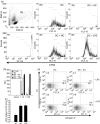
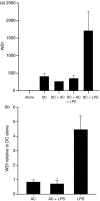
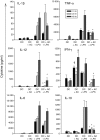
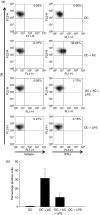

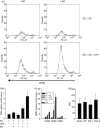
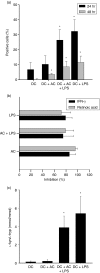
Similar articles
-
Interferon-gamma-triggered indoleamine 2,3-dioxygenase competence in human monocyte-derived dendritic cells induces regulatory activity in allogeneic T cells.Blood. 2009 Oct 8;114(15):3235-43. doi: 10.1182/blood-2008-12-195073. Epub 2009 Jul 22. Blood. 2009. PMID: 19625705
-
IFN-gamma-indoleamine-2,3 dioxygenase acts as a major suppressive factor in 4-1BB-mediated immune suppression in vivo.J Leukoc Biol. 2009 May;85(5):817-25. doi: 10.1189/jlb.0408246. Epub 2009 Feb 13. J Leukoc Biol. 2009. PMID: 19218483 Free PMC article.
-
Glycogen Synthase Kinase-3β (GSK-3β) Inhibition Enhances Dendritic Cell-based Cancer Vaccine Potency via Suppression of Interferon-γ-induced Indoleamine 2,3-Dioxygenase Expression.J Biol Chem. 2015 May 8;290(19):12394-402. doi: 10.1074/jbc.M114.628578. Epub 2015 Mar 26. J Biol Chem. 2015. PMID: 25814664 Free PMC article.
-
Implications of IFN-gamma-mediated tryptophan catabolism on solid organ transplantation.Curr Drug Metab. 2007 Apr;8(3):273-82. doi: 10.2174/138920007780362536. Curr Drug Metab. 2007. PMID: 17430115 Review.
-
IDO: a double-edged sword for T(H)1/T(H)2 regulation.Immunol Lett. 2008 Nov 16;121(1):1-6. doi: 10.1016/j.imlet.2008.08.008. Epub 2008 Sep 29. Immunol Lett. 2008. PMID: 18824197 Free PMC article. Review.
Cited by
-
Innate immune activation by tissue injury and cell death in the setting of hematopoietic stem cell transplantation.Front Immunol. 2015 Mar 16;6:101. doi: 10.3389/fimmu.2015.00101. eCollection 2015. Front Immunol. 2015. PMID: 25852683 Free PMC article. Review.
-
How apoptotic β-cells direct immune response to tolerance or to autoimmune diabetes: a review.Apoptosis. 2015 Mar;20(3):263-72. doi: 10.1007/s10495-015-1090-8. Apoptosis. 2015. PMID: 25604067 Free PMC article. Review.
-
Inhibition of allogeneic T-cell response by Kupffer cells expressing indoleamine 2,3-dioxygenase.World J Gastroenterol. 2010 Feb 7;16(5):636-40. doi: 10.3748/wjg.v16.i5.636. World J Gastroenterol. 2010. PMID: 20128035 Free PMC article.
-
Vitamin D3 Priming of Dendritic Cells Shifts Human Neutrophil-Dependent Th17 Cell Development to Regulatory T Cells.Front Immunol. 2022 Jul 7;13:872665. doi: 10.3389/fimmu.2022.872665. eCollection 2022. Front Immunol. 2022. PMID: 35874744 Free PMC article.
-
A Bidens pilosa L. Non-Polar Extract Modulates the Polarization of Human Macrophages and Dendritic Cells into an Anti-Inflammatory Phenotype.Molecules. 2023 Oct 14;28(20):7094. doi: 10.3390/molecules28207094. Molecules. 2023. PMID: 37894572 Free PMC article.
References
-
- Banchereau J, Steinman RM. Dendritic cells and the control of immunity. Nature. 1998;392:245–52. - PubMed
-
- Banchereau J, Palucka AK. Dendritic cells as therapeutic vaccines against cancer. Nat Rev Immunol. 2005;5:296–306. - PubMed
-
- Lutz MB, Schuler G. Immature, semi-mature and fully mature dendritic cells: which signals induce tolerance or immunity? Trends Immunol. 2002;23:445–9. - PubMed
-
- Albert ML. Death-defying immunity: do apoptotic cells influence antigen processing and presentation? Nat Rev Immunol. 2004;4:223–31. - PubMed
-
- Fiers W, Beyaert R, Declercq W, Vandenabeele P. More than one way to die: apoptosis, necrosis and reactive oxygen damage. Oncogene. 1999;18:7719–30. - PubMed
Publication types
MeSH terms
Substances
LinkOut - more resources
Full Text Sources
Other Literature Sources
Research Materials

